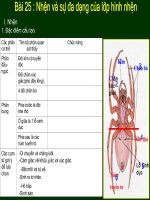Tải Giáo án tiếng Anh lớp 10 Tuần 26 sách mới - Giáo án điện tử môn tiếng Anh 10 theo tuần
Bạn đang xem bản rút gọn của tài liệu. Xem và tải ngay bản đầy đủ của tài liệu tại đây (99.59 KB, 9 trang )
<span class='text_page_counter'>(1)</span><div class='page_container' data-page=1>
<b>GIÁO ÁN TIẾNG ANH LỚP 10 TUẦN 26</b>
<b>NĂM 2019 - 2020</b>
<b>PERIOD: 76 UNIT 8: NEW WAYS TO LEARN</b>
<i>Date of planning: LANGUAGE</i>
<i><b>Date of teaching: </b></i>
<b>I. AIMS/OBJECTIVES OF THE LESSON</b>
<b>1. Language focus</b>
- To help learners get started with some language items in Unit 8
- For vocabulary, that is words and phrases related to electronic devices that can help us learn
and using the Internet to learn English
- For pronunciation, that is stress in 3 syllable adjectives and verbs
- For grammar, that is relative clauses
<b>2. Skills</b>
- To promote Ss to develop the skill of working in pairs and groups
<b>3. Attitudes</b>
- To encourage Ss to work harder
- To provide Ss some motivation
<b>II. PREPARATION</b>
<b>1. Teacher</b>
<b>- Teaching aids: textbook, lesson plan</b>
- Teaching method: Communicative language teaching
<b>2. Students</b>
- Read through English Unit 8 - language at home
</div>
<span class='text_page_counter'>(2)</span><div class='page_container' data-page=2>
<b>1. Class organization (1 minute)</b>
<b>2. Check up (5 minutes)</b>
<b>- Ask some Ss to write some new words and do the tasks again</b>
<b>3. New lesson (35 minutes)</b>
<b>TEACHER'S ACTIVITIES</b> <b>STUDENTS' ACTIVITIES</b>
<b>VOCABULARY</b>
<b>1. Match each of the phrases on the left </b>
<b>with its explanation on the right.</b>
<b>- Do as appointed</b>
1. e
2. d
3. b
4. c
5. a
<b>2. Read the conversation in getting </b>
<b>started again. Match picture A- C with </b>
<b>their uses as learning tools 1-6 </b>
<b>mentioned above</b>
1. B
2. C
3. A
4. B
5. B
6. C
<b>PRONUNCIATION</b>
<b>1. Listen and repeat</b>
Do as appointed
<b>2. Listen again and put a mark before </b>
<b>the stressed syllable in each word</b>
- Do as appointed
<b>concentrate</b>
<b>similar</b>
<b>contribute</b>
</div>
<span class='text_page_counter'>(3)</span><div class='page_container' data-page=3>
<b>introduce</b>
<b>excellent</b>
<b>recognise</b>
<b>Vietnamese</b>
<b>understand</b>
<b>personal</b>
<b>interest</b>
<b>symbolic</b>
<b>Grammar</b>
<b>Relative Clauses</b>
<b>1. Read the following sentences from </b>
<b>getting started. Underline which, that, </b>
<b>who and whose</b>
1. They are the modern devices that have
changed the way we learn
2. Smartphone can also be used to take
photos or record students' work, which can
be later shared with the class
3. You can also access the internet,
download programmes and information that
can help you understand the material and
widen your knowledge
4. My laptop which is a present from my
parents, is very useful
5. A tablet is also perfect for people whose
work is to draw and write
<b>2. Mark 1-6 with a-f to make </b>
<b>meaningful sentences</b>
1. e
2. d
3. a
4. f
</div>
<span class='text_page_counter'>(4)</span><div class='page_container' data-page=4>
6. b
<b>3. Use who, which, that or whose to </b>
<b>complete each of the sentences</b>
1. which/that
2. whose
3. which
4. who/that
5. whose
6. who
<b>4. Consolidation (3 mins)</b>
- Vocabulary related to personal electronic device and the internet
- Relative clauses
- Stress of 3-syllable adjectives and verbs
<b>5. Homework: (1 min)</b>
- Vocabulary related to personal electronic device and the internet
- Relative clauses
- Stress of 3-syllable adjectives and verbs
- Do the task again
- Read Unit 8 - Reading at home
<b>PERIOD: 77 UNIT 8: NEW WAYS TO LEARN</b>
<i>Date of planning: READING - Digital English</i>
<i><b>Date of teaching: </b></i>
<b>I. AIMS/OBJECTIVES OF THE LESSON</b>
<b>1. Language focus</b>
</div>
<span class='text_page_counter'>(5)</span><div class='page_container' data-page=5>
<b>2. Skills</b>
- To promote Ss to develop their reading skills
- Skim the text to get the general idea
- Scan the text to get some specific details
<b>3. Attitudes</b>
- To encourage Ss to work harder
- To provide Ss some motivation
<b>II. PREPARATION</b>
<b>1. Teacher</b>
<b>- Teaching aids: textbook, lesson plan</b>
- Teaching method: Communicative language teaching
<b>2. Students</b>
- Read through English Unit 8 - Reading at home
<b>III. PROCEDURE</b>
<b>1. Class organization (1 minute)</b>
<b>2. Check up (5 minutes)</b>
<b>- Ask some Ss to do the tasks again</b>
<b>3. New lesson (35 minutes)</b>
<b>TEACHER'S ACTIVITIES</b> <b>STUDENTS' ACTIVITIES</b>
<b>PRE READING</b>
<b>1. Look at the picture. What are the </b>
<b>students doing?</b>
Students are learning with personal
electronic devices
<b>2. Match each of the words or phrase </b>
<b>with its meaning</b>
1. c
</div>
<span class='text_page_counter'>(6)</span><div class='page_container' data-page=6>
3. a
4. e
5. f
6. b
<b>WHILE READING</b>
<b>3. Quickly read the text and select the </b>
<b>best title for it</b>
The best title of the reading passage is B –
New ways to learn English
<b>4. Read the text again. Answer the </b>
<b>question</b>
1. We can put them in mobile devices and
study anywhere
2. We can see words on the screen and hear
them spoken
3. We can choose to practise with native
English speakers of different accents and
genders.
4. They use them to record real-life English,
lessons, learning materials, songs or English
language films from television or the
Internet
5. Because it will make learning English
easier, faster, more effective and more
enjoyable.
<b>POST READING</b>
<b>5. Discuss in pairs or groups. </b>
- Do as appointed
I have an old mobile phone. I use it for
communication only. Some of my
classmates have modern smartphones and
laptops so they use these devices to record
materials, look up new words, download and
store digital lessons and practise. The
</div>
<span class='text_page_counter'>(7)</span><div class='page_container' data-page=7>
pronunciation and vocabulary
<b>4. Consolidation (3 mins)</b>
- Vocabulary related to personal digital devices
- Reading skills: skimming, scanning, guessing the meaning of new words/phrases through
context
<b>5. Homework: (1 min)</b>
- Vocabulary related to personal digital devices
- Reading skills: skimming, scanning, guessing the meaning of new words/phrases through
context
- Do the task again
- Read Unit 8 - Speaking at home
<b>PERIOD: 78 UNIT 8: NEW WAYS TO LEARN </b>
<i>Date of planning: SPEAKING – Go Digital</i>
<i><b>Date of teaching: </b></i>
<b>I. AIMS/OBJECTIVES OF THE LESSON</b>
<b>1. Language focus</b>
- To provide learners some vocabulary related to digital devices
<b>2. Skills</b>
- To promote Ss to develop their speaking skills
- To help Ss develop the skill of working in pairs and groups
<b>3. Attitudes</b>
- To encourage Ss to work harder
- To provide Ss some motivation
</div>
<span class='text_page_counter'>(8)</span><div class='page_container' data-page=8>
<b>1. Teacher</b>
<b>- Teaching aids: textbook, lesson plan</b>
- Teaching method: Communicative language teaching
<b>2. Students</b>
- Read through English Unit 8 - Speaking at home
<b>III. PROCEDURE</b>
<b>1. Class organization (1 minute)</b>
<b>2. Check up (5 minutes)</b>
<b>- Ask some Ss to do the tasks again</b>
<b>3. New lesson (35 minutes)</b>
<b>TEACHER'S ACTIVITIES</b> <b>STUDENTS' ACTIVITIES</b>
<b>1. Look at some arguments in favour of </b>
<b>using electronic devices in learning.</b>
Do as appointed
1. d
2. b
3. c
4. a
<b>2. Work in pairs. Read the arguments </b>
<b>and explanations in 1again.</b>
Do as appointed
The two most effective ways of using
electronic devices are ... because ...
We think/believe ... is an effective way of
using ... because ...
In my opinion ...
<b>3. Work in pairs. Discuss how useful </b>
<b>electronic devices are in learning</b>
Do as appointed
</div>
<span class='text_page_counter'>(9)</span><div class='page_container' data-page=9>
B: Exactly Students who hate homework can
have fun doing it on tablet
A: And when they type on tablets they can
change or add more things any time they
want
<b>4. Work in groups. Answer the </b>
<b>following questions. Note down your </b>
<b>partner's answers and report them to </b>
<b>the class</b>
Do as appointed
<b>4. Consolidation (3 mins)</b>
- Vocabulary related to electrical and digital devices
- Speaking skills: Talking about the usefulness of digital devices
<b>5. Homework: (1 min)</b>
- Vocabulary related to electrical and digital devices
- Speaking skills: Talking about the usefulness of digital devices
- Do the tasks again
- Read Unit 8 - Listening at home
Mời bạn đọc tham khảo thêm tài liệu Tiếng Anh lớp 10 tại đây:
Bài tập Tiếng Anh lớp 10 theo từng Unit:
Bài tập Tiếng Anh lớp 10 nâng cao:
</div>
<!--links-->









